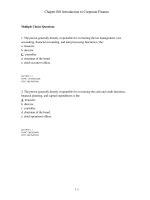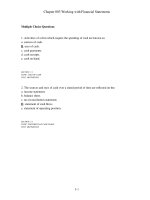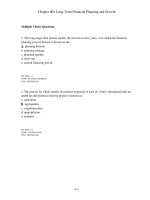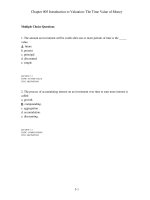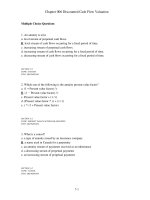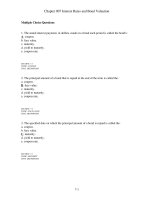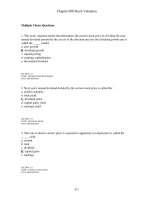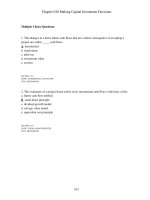Test bank corporate finance 8e ros chap014
Bạn đang xem bản rút gọn của tài liệu. Xem và tải ngay bản đầy đủ của tài liệu tại đây (184.87 KB, 48 trang )
Chapter 014 Options and Corporate Finance
Multiple Choice Questions
1. A contract that grants its owner the right to buy or sell a specified asset at an agreed-upon
price on or before a given date is called a(n):
A. option.
b. invoice.
c. exercise.
d. swap.
e. straddle.
SECTION: 14.1
TOPIC: OPTION
TYPE: DEFINITIONS
2. Exercising an option is the act of:
a. buying the right to either buy or sell an asset at a specified price for a stated period of time.
b. purposely allowing an option to expire.
C. buying or selling the underlying asset via the option contract.
d. purchasing a second option to exactly offset an option which you currently own.
e. purchasing shares of stock in the open market to offset an option position.
SECTION: 14.1
TOPIC: EXERCISING THE OPTION
TYPE: DEFINITIONS
3. The fixed price in an option contract at which the holder can buy or sell the underlying
asset is called the option's:
a. opening price.
b. intrinsic value.
C. strike price.
d. market price.
e. time value.
SECTION: 14.1
TOPIC: STRIKE PRICE
TYPE: DEFINITIONS
14-1
Chapter 014 Options and Corporate Finance
4. The last day on which an option can be exercised is the _____ date.
a. ex-payment
b. ex-option
c. opening
D. expiration
e. intrinsic
SECTION: 14.1
TOPIC: EXPIRATION DATE
TYPE: DEFINITIONS
5. An option that may be exercised at any time before it expires is called a(n) _____ option.
a. flexible
b. portable
c. daily
d. European
E. American
SECTION: 14.1
TOPIC: AMERICAN OPTIONS
TYPE: DEFINITIONS
6. An option that may be exercised only on the expiration date is called a(n) _____ option.
A. European
b. American
c. inflexible
d. dated
e. pointed
SECTION: 14.1
TOPIC: EUROPEAN OPTIONS
TYPE: DEFINITIONS
14-2
Chapter 014 Options and Corporate Finance
7. A call option is the _____ an asset at a fixed price during a stated period of time.
a. right to sell
B. right to buy
c. obligation to sell
d. obligation to buy
e. obligation to trade
SECTION: 14.1
TOPIC: CALL OPTION
TYPE: DEFINITIONS
8. A put option is the _____ an asset at a fixed price during a stated period of time.
A. right to sell
b. right to buy
c. obligation to sell
d. obligation to buy
e. obligation to trade
SECTION: 14.1
TOPIC: PUT OPTION
TYPE: DEFINITIONS
9. The value of an option if it were about to expire is called the _____ value.
a. strike
b. upper
c. deadline
d. time
E. intrinsic
SECTION: 14.2
TOPIC: INTRINSIC VALUE
TYPE: DEFINITIONS
14-3
Chapter 014 Options and Corporate Finance
10. The right granted to a company employee which enables that employee to buy shares of
stock in the company at a set price for a fixed period of time is called a(n):
A. employee stock option.
b. company bonus option.
c. employee grant.
d. employee exercise option.
e. company benefits option.
SECTION: 14.6
TOPIC: EMPLOYEE STOCK OPTION
TYPE: DEFINITIONS
11. An option based on an underlying asset such as a building or land is called a _____
option.
a. financial
b. liquid
c. fixed
D. real
e. tangible
SECTION: 14.4
TOPIC: REAL OPTION
TYPE: DEFINITIONS
12. The investment timing decision is the:
a. determination of when an option should be exercised.
b. decision of when to purchase an option on an underlying asset.
c. analysis of determining when an asset should be sold.
d. determination of when a project should be abandoned.
E. evaluation of the optimal time to begin a project.
SECTION: 14.6
TOPIC: INVESTMENT TIMING DECISION
TYPE: DEFINITIONS
14-4
Chapter 014 Options and Corporate Finance
13. Managerial options are:
a. choices managers can make given today's circumstances.
b. various rights that a manager has today given the calls owned by the firm.
c. choices that are independent of all future events.
D. opportunities that managers can exploit if certain things happen in the future.
e. various methods a manager can utilize to produce a specific product.
SECTION: 14.6
TOPIC: MANAGERIAL OPTIONS
TYPE: DEFINITIONS
14. When a person takes into account the managerial options implicit in a project, that person
is conducting:
a. financial planning.
B. contingency planning.
c. asset management reviews.
d. a prospective evaluation.
e. strategic evaluations.
SECTION: 14.6
TOPIC: CONTINGENCY PLANNING
TYPE: DEFINITIONS
15. Options for future, related business products or strategies are referred to as _____
options.
a. financial
B. strategic
c. expansion
d. real
e. managerial
SECTION: 14.6
TOPIC: STRATEGIC OPTIONS
TYPE: DEFINITIONS
14-5
Chapter 014 Options and Corporate Finance
16. A security that gives the holder the right to purchase shares of stock at a fixed price over a
specified period of time is called a(n):
a. convertible bond.
B. warrant.
c. initial public offering.
d. seasoned equity offering.
e. put.
SECTION: 14.7
TOPIC: WARRANT
TYPE: DEFINITIONS
17. A bond that can be exchanged for a fixed number of shares of stock over a specified
period of time is called a _____ bond.
a. secured
b. warranted
C. convertible
d. junk
e. callable
SECTION: 14.7
TOPIC: CONVERTIBLE BOND
TYPE: DEFINITIONS
18. The dollar amount of a bond's par value that is exchangeable for one share of stock is
called the:
a. conversion premium.
b. par value.
c. conversion value.
D. conversion price.
e. conversion ratio.
SECTION: 14.7
TOPIC: CONVERSION PRICE
TYPE: DEFINITIONS
14-6
Chapter 014 Options and Corporate Finance
19. The number of shares of stock received for each bond that is converted is called the:
a. conversion premium.
b. straight bond value.
c. conversion value.
d. conversion price.
E. conversion ratio.
SECTION: 14.7
TOPIC: CONVERSION RATIO
TYPE: DEFINITIONS
20. The difference between the conversion price and the current stock price, divided by the
current stock price, is called the:
A. conversion premium.
b. straight bond value.
c. conversion value.
d. conversion price.
e. conversion ratio.
SECTION: 14.7
TOPIC: CONVERSION PREMIUM
TYPE: DEFINITIONS
21. The value a convertible bond would have if it could not be converted into common stock
is called the:
a. conversion premium.
B. straight bond value.
c. conversion value.
d. conversion price.
e. conversion ratio.
SECTION: 14.7
TOPIC: STRAIGHT BOND VALUE
TYPE: DEFINITIONS
14-7
Chapter 014 Options and Corporate Finance
22. The value a convertible bond would have if it were to be immediately converted into
common stock is called the:
a. conversion premium.
b. straight bond value.
C. conversion value.
d. conversion price.
e. conversion ratio.
SECTION: 14.7
TOPIC: CONVERSION VALUE
TYPE: DEFINITIONS
23. Which one of the following statements correctly describes your situation as the holder of
an American call option?
a. You are obligated to buy if the option is exercised.
b. You have a right to sell.
c. You have a right to buy but only on the expiration date.
d. You are obligated to sell if the option is exercised.
E. You have a right to buy at any time before the option expires.
SECTION: 14.1
TOPIC: AMERICAN OPTION
TYPE: CONCEPTS
24. Max opted to exercise his July option on June 11 and as a result received $4,600 in cash.
Max must have owned a (an):
a. warrant.
b. American call.
C. American put.
d. European call.
e. European put.
SECTION: 14.1
TOPIC: AMERICAN OPTION
TYPE: CONCEPTS
14-8
Chapter 014 Options and Corporate Finance
25. Maria opted to exercise her December option at the end of October and paid $2,600 at that
time to acquire 100 shares of stock. Maria probably owned an:
A. American call.
b. American put.
c. European call.
d. European put.
e. European convertible bond.
SECTION: 14.1
TOPIC: AMERICAN OPTION
TYPE: CONCEPTS
26. Jessica owns an option which gives her the right to purchase shares of TRU-LUV stock at
a price of $57.50 a share. Currently, TRU-LUV is selling for $62.60. Jessica would like to
realize her profits but is not permitted to exercise the option for another three weeks. Jessica
must own a(n):
a. warrant.
b. American call.
c. American put.
D. European call.
e. European put.
SECTION: 14.1
TOPIC: EUROPEAN OPTION
TYPE: CONCEPTS
14-9
Chapter 014 Options and Corporate Finance
27. What is the key difference between an American call option and a European call option?
a. The American call has a fixed strike price while the European strike price varies each
month.
b. An American call is a right to buy while a European call is an obligation to buy.
c. An American call has an expiration date while the European call does not.
d. An American call is written on 100 shares of the underlying security while the European
call covers 1,000 shares.
E. An American call an be exercised at any time up to the expiration date while the European
call can only be exercised on the expiration date.
SECTION: 14.1
TOPIC: EUROPEAN OPTION
TYPE: CONCEPTS
14-10
Chapter 014 Options and Corporate Finance
28. If a call has a positive intrinsic value the call is said to be:
a. funded.
b. unfunded.
c. at the money.
D. in the money.
e. out of the money.
SECTION: 14.2
TOPIC: CALL VALUE
TYPE: CONCEPTS
29. A 25 put option on West Ridge stock expires today. The current price of West Ridge stock
is $27. The put is:
a. funded.
b. unfunded.
c. at the money.
d. in the money.
E. out of the money.
SECTION: 14.2
TOPIC: PUT VALUE
TYPE: CONCEPTS
30. The maximum value of a call option is equal to:
a. the strike price minus the initial cost of the option.
b. the exercise price plus the price of the underlying stock.
c. the strike price.
D. the price of the underlying stock.
e. the purchase price.
SECTION: 14.2
TOPIC: CALL UPPER BOUND
TYPE: CONCEPTS
14-11
Chapter 014 Options and Corporate Finance
31. The lower bound on a call's value is either the:
a. strike price or zero, whichever is greater.
B. stock price minus the exercise price or zero, whichever is greater.
c. strike price or the stock price, whichever is lower.
d. strike price or zero, whichever is lower.
e. stock price minus the exercise price or zero, whichever is lower.
SECTION: 14.2
TOPIC: CALL LOWER BOUND
TYPE: CONCEPTS
32. The intrinsic value of a call is:
a. the upper bound value.
B. the lower bound value.
c. another name for the market price.
d. equal to zero if the call is in the money.
e. greater than zero if the call is out of the money.
SECTION: 14.2
TOPIC: CALL INTRINSIC VALUE
TYPE: CONCEPTS
33. The intrinsic value of a put is equal to the:
a. lesser of the strike price or the stock price.
b. lesser of the stock price minus the exercise price or zero.
c. lesser of the stock price or zero.
D. greater of the strike price minus the stock price or zero.
e. greater of the stock price minus the exercise price or zero.
SECTION: 14.2
TOPIC: PUT INTRINSIC VALUE
TYPE: CONCEPTS
14-12
Chapter 014 Options and Corporate Finance
34. Which one of the following statements is correct?
A. The value of a call increases as the price of the underlying stock increases.
b. The value of a call increases as the exercise price increases.
c. The value of a put increases as the price of the underlying stock increases.
d. The value of a put decreases as the exercise price increases.
e. The intrinsic value of a put must be zero on the expiration date.
SECTION: 14.2
TOPIC: FACTORS AFFECTING OPTION VALUES
TYPE: CONCEPTS
35. An increase in which of the following will increase the value of a call?
I. time to expiration
II. underlying stock price
III. risk-free rate of return
IV. price volatility of the underlying stock
a. I and III only
b. II, III, and IV only
c. I, III, and IV only
d. I, II, and III only
E. I, II, III, and IV
SECTION: 14.2
TOPIC: FACTORS AFFECTING OPTION VALUES
TYPE: CONCEPTS
14-13
Chapter 014 Options and Corporate Finance
36. Which of the following factors affect the value of a call option?
I. exercise price
II. time to expiration
III. risk-free rate
IV. price of underlying asset
a. I and II only
b. III and IV only
c. I, II, and IV only
d. I, II, and III only
E. I, II, III, and IV
SECTION: 14.2
TOPIC: FACTORS AFFECTING OPTION VALUES
TYPE: CONCEPTS
14-14
Chapter 014 Options and Corporate Finance
37. Assume that you own both a July 25 put and a July 25 call on Delta stock. Which one of
the following statements is correct concerning these option positions? Ignore taxes and
transaction costs.
a. A price decrease in Delta stock will increase the call value and decrease the put value.
b. A July 30 call is worth more than your July 25 call.
c. The time premium on your July 25 put is greater than the time premium on an August 25
put.
D. A price increase in Delta stock from $26 to $28 will increase the value of your call.
e. An increase of $1 in your put value must decrease the value of your call by $1.
SECTION: 14.2
TOPIC: OPTION VALUES
TYPE: CONCEPTS
38. You own both a November 45 call and a November 45 put. If the put finishes in the
money, then the call will:
a. also finish in the money.
b. finish at the money.
C. finish out of the money.
d. either finish at the money or in the money.
e. either finish at the money or out of the money.
SECTION: 14.2
TOPIC: OPTION VALUES
TYPE: CONCEPTS
14-15
Chapter 014 Options and Corporate Finance
39. Which one of the following statements regarding employee stock options (ESOs) is
correct?
a. ESOs grant an employee the right to buy a fixed number of shares of company stock at the
market price.
b. If employees want to exercise their ESOs, they must do so prior to the ESOs becoming
vested.
C. Employees may lose their ESOs if they leave their job.
d. ESOs are sometimes used as a motivator to encourage employees to focus on their personal
goals.
e. Employees can sell their ESOs if they do not want to personally exercise them.
SECTION: 14.4
TOPIC: EMPLOYEE STOCK OPTION
TYPE: CONCEPTS
14-16
Chapter 014 Options and Corporate Finance
40. Employee stock options are designed:
a. to be backdated to any desired date over the past year.
b. to provide a large initial tax deduction to the employer.
C. to influence the actions and priorities of employees.
d. as a means of distributing excess cash to the employees.
e. to be traded on the open market without incurring transaction costs.
SECTION: 14.4
TOPIC: EMPLOYEE STOCK OPTION
TYPE: CONCEPTS
41. Employee stock options:
a. usually have a positive intrinsic value when they are issued.
B. are frequently granted on a regular basis such as quarterly or annually.
c. are generally in the money when they are issued.
d. are frequently repriced when they are in the money.
e. are considered to be "underwater" when they have a positive intrinsic value.
SECTION: 14.4
TOPIC: EMPLOYEE STOCK OPTON
TYPE: CONCEPTS
42. How many business days after the grant date do firms have under the Sarbanes-Oxley Act
of 2002 to report the option grants?
a. 1
B. 2
c. 3
d. 4
e. 5
SECTION: 14.4
TOPIC: ESO BACKDATING
TYPE: CONCEPTS
14-17
Chapter 014 Options and Corporate Finance
43. Trenton Industrial Fans has a pure discount loan with a face value of $250,000 due in one
year. The assets of the firm are currently worth $315,000. The shareholders in this firm
basically own a _____ option on the assets of the firm with a strike price of:
a. put; $250,000.
b. put; $315,000.
c. warrant; $315,000.
D. call; $250,000.
e. call; $315,000.
SECTION: 14.5
TOPIC: EQUITY AS A CALL OPTION
TYPE: CONCEPTS
44. Jason and Julie are house hunting. They find House A that they really like but want to
continue searching the market for one more week before making a final decision on buying
the house. To avoid having someone else purchase House A while they continue their house
hunting, they decide to place a $1,000 deposit on House A. This deposit will apply to the
purchase price if they buy House A. If they do not buy House A, they will forfeit the $1,000.
Essentially, Jason and Julie have a _____ on House A.
a. financial put
b. financial call
c. warrant
d. real put
E. real call
SECTION: 14.6
TOPIC: REAL OPTIONS
TYPE: CONCEPTS
14-18
Chapter 014 Options and Corporate Finance
45. The option to wait:
I. may be of minimal value if a project is dependent upon rapidly changing technology.
II. is partially dependent upon the discount rate applied to the project being evaluated.
III. is defined as temporarily shutting down a project for a period of time.
IV. has a value equal to the NPV of a project if it is started at a later date minus the NPV if
the project is started today.
a. I and III only
b. II and IV only
c. I and II only
d. II, III, and IV only
E. I, II, and IV only
SECTION: 14.6
TOPIC: OPTION TO WAIT
TYPE: CONCEPTS
46. Ignoring which of the following will cause the NPV of a project to be underestimated?
I. option to abandon
II. option to expand
III. option to wait
IV. option to contract
a. I and III only
b. II, III, and IV only
c. I, II, and III only
d. I, III, and IV only
E. I, II, III, and IV
SECTION: 14.6
TOPIC: MANAGERIAL OPTIONS
TYPE: CONCEPTS
14-19
Chapter 014 Options and Corporate Finance
47. Which one of the following is an example of a strategic option for a restaurant?
A. opening a new restaurant with a different look and an entirely different menu to see if that
type of restaurant appeals to the public
b. deciding to close one hour earlier during the winter months due to weak demand
c. stopping a 3-year project after six months due to a lack of consumer demand
d. deciding to open only two new retail outlets next year instead of the five that were
originally scheduled
e. deciding to create separate lunch and dinner menus rather than have them combined on one
menu
SECTION: 14.6
TOPIC: STRATEGIC OPTIONS
TYPE: CONCEPTS
48. Last month, you introduced a new product to the market. Consumer demand has been
overwhelming and appears that strong demand will exist over the long-term. Given this
situation, management should consider the option to:
a. suspend.
B. expand.
c. abandon.
d. contract.
e. withdraw.
SECTION: 14.6
TOPIC: OPTION TO EXPAND
TYPE: CONCEPTS
14-20
Chapter 014 Options and Corporate Finance
49. Three months ago, you introduced a new toy which you thought would be a fast seller. To
your surprise, children do not like the toy so sales have been abysmal. You should consider
the option to:
a. suspend.
b. expand.
C. abandon.
d. contract.
e. re-introduce.
SECTION: 14.6
TOPIC: OPTION TO ABANDON
TYPE: CONCEPTS
14-21
Chapter 014 Options and Corporate Finance
50. Which of the following are managerial options once a project is commenced?
I. modifying the production process
II. re-pricing the product
III. changing the advertising
IV. changing the packaging
a. I and II only
b. III and IV only
c. I, II, and III only
d. II, III, and IV only
E. I, II, III, and IV
SECTION: 14.6
TOPIC: MANAGERIAL OPTIONS
TYPE: CONCEPTS
51. Warrants are generally:
a. issued in connection with publicly traded bonds.
b. traded directly between individuals rather than on an exchange.
c. structured similar to long-term put options.
d. issued by individuals.
E. added as part of a private debt issue.
SECTION: 14.7
TOPIC: WARRANTS
TYPE: CONCEPTS
14-22
Chapter 014 Options and Corporate Finance
52. Which of the following statements are correct concerning warrants?
I. Warrants are similar to put options.
II. Warrants are similar to call options.
III. When a warrant is exercised, the issuer is not involved in the transaction.
IV. When a warrant is exercised, the issuer must issue new shares of stock.
a. I only
b. II only
c. I and III only
D. II and IV only
e. I and IV only
SECTION: 14.7
TOPIC: WARRANTS
TYPE: CONCEPTS
14-23
Chapter 014 Options and Corporate Finance
53. When warrants are exercised, the:
A. earnings per share decrease.
b. earnings per share remain constant.
c. total equity in a firm remains constant.
d. total equity in a firm decreases.
e. number of bonds outstanding increases.
SECTION: 14.7
TOPIC: WARRANTS
TYPE: CONCEPTS
54. Which of the following statements are correct concerning convertible bonds?
I. New shares of stock are issued when a convertible bond is converted.
II. A convertible bond is similar to a bond with a put option.
III. A convertible bond should never be worth less than its straight bond value.
IV. A convertible bond can be described as having upside potential with downside protection.
a. I and III only
b. II and IV only
c. I, II, and III only
D. I, III, and IV only
e. II, III, and IV only
SECTION: 14.7
TOPIC: CONVERTIBLE BONDS
TYPE: CONCEPTS
55. The conversion value of a convertible bond is computed as the:
A. conversion ratio multiplied by the stock price.
b. conversion ratio multiplied by the conversion price.
c. face value of the bond plus the conversion premium.
d. face value of the bond multiplied by (1 + Conversion premium).
e. stock price multiplied by (1 + Conversion price).
SECTION: 14.7
TOPIC: CONVERTIBLE BONDS
TYPE: CONCEPTS
14-24
Chapter 014 Options and Corporate Finance
56. The maximum value of a convertible bond is theoretically:
a. equal to the conversion value minus the straight bond value.
b. equal to the face value of the bond multiplied by (1 + Conversion price).
c. limited to the maximum straight bond value.
d. limited by the face value of the bond.
E. unlimited.
SECTION: 14.7
TOPIC: CONVERTIBLE BONDS
TYPE: CONCEPTS
57. What is the cost of three August 35 call option contracts on BeTa stock given the
following price quotes?
a. $0.60
b. $6.80
C. $60.00
d. $1,230
e. $2,040
Cost = 3
100
$.20 = $60
AACSB TOPIC: ANALYTIC
SECTION: 14.1
TOPIC: OPTION QUOTES
TYPE: PROBLEMS
14-25
